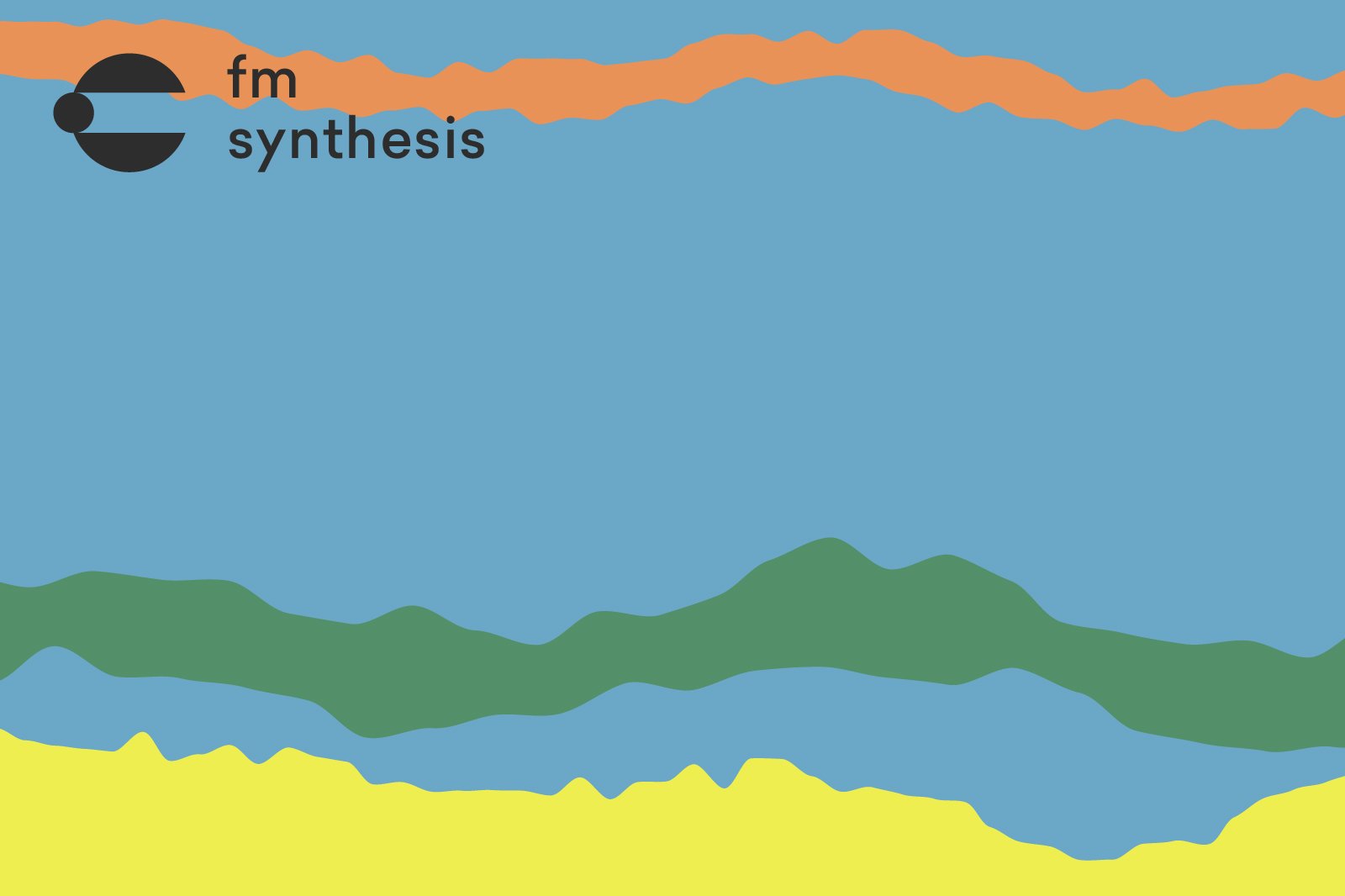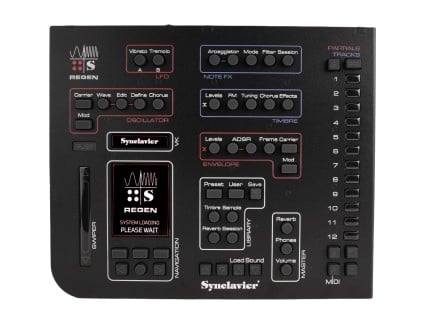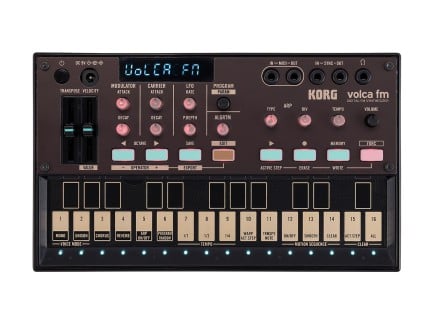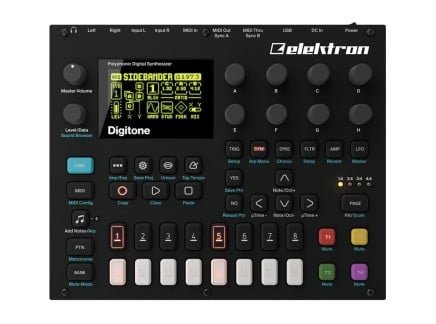The world of sound synthesis is multifaceted, abounding with possibilities to generate, recreate, and modify sonic content. We can make a comparison to visual artists: different kinds of paints create different aesthetic possibilities, right? So, we can think of various sound synthesis approaches similarly: they allow musicians and composers to explore novel types of sound. (Hopefully you've begun to understand some of the distinct flavors possible in our recent articles on Subtractive Synthesis and Additive Synthesis.)
Frequency modulation synthesis (or FM for short) is undoubtedly one of the best-known and widely-used approaches. However, like many concepts related to the art and science of electronic sounds, FM synthesis is a bit of a tangled term that requires some unpacking. And this is precisely what we are attempting to do here.
In this article, we are going to discuss frequency modulation synthesis in depth, tracing its evolution from being used in some of the earliest electronic music inventions to comprehensive approaches developed over the years. We will emphasize nuances of the approach within analog and digital domains, indicating different methods of achieving the effect. Along the way, we will also explore a number of classic and modern instruments that incorporated frequency modulation in their designs.
What Is FM Synthesis?
The basic principle of FM synthesis is quite simple. In essence, we need at minimum two oscillators. One of them acts as a carrier—it produces the sound that we hear. The second oscillator is called the modulator: it is used to modulate the frequency of the carrier. We don't listen to the modulator directly (not in this example, at least), but we hear its effect as a timbral change in the tone of the first oscillator. By running the modulator at a high frequency (in the audio range), we can create a wide variety of complex tones.
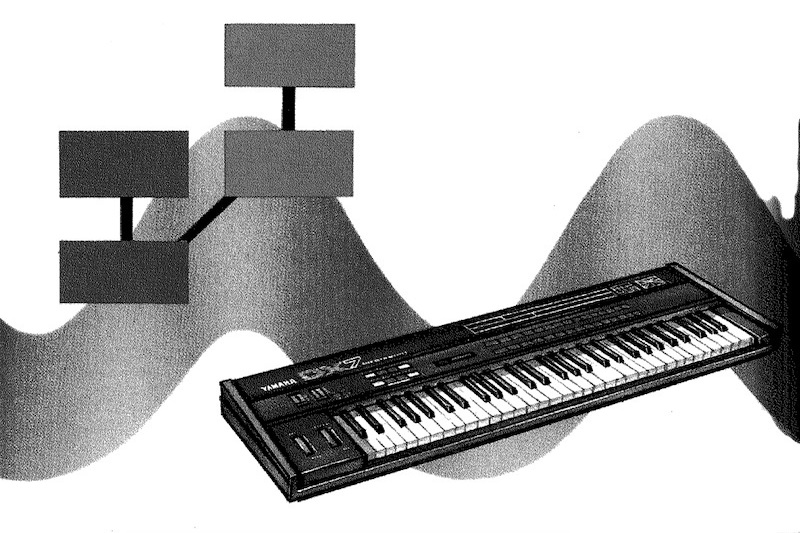
So in simple terms: What is FM Synthesis? FM synthesis is a specialized means of shaping sound by using multiple oscillators to modulate one another's frequencies.
The frequency modulation technique allows us to produce both tonal and discordant sounds. The resulting sound's quality is primarily defined by the harmonic relationship between the frequencies of the two oscillators (their frequency ratio). If the frequency ratio between the carrier and the modulator is a whole number integer value, then the resulting tone will be relatively stable/harmonic. If the ratio is more complex, the sound will be more inharmonic or dissonant.
Another important parameter to introduce is the modulation index. This refers to the amplitude level of the modulating oscillator—controlling the intensity or depth of the modulation effect applied to the frequency of the carrier. As you would expect, the higher the modulation index, the more pronounced the result.
While this effectively summarizes the core concepts of the FM technique, it is still far from what we now culturally define as "FM Synthesis." In the following sections, we will learn more about the distinction between the tone-altering technique, and the comprehensive approach to sound design.
The Origins Of Analog FM
In some ways, we can think of the frequency modulation technique as having been discovered in 1933 by the engineer Edwin Armstrong—and since then it has been implemented for high-fidelity radio broadcasting worldwide.
However, its clearest integration into the world of "commercial" synthesizer design begins with Don Buchla's experimental modular synthesizer systems, which he started developing in mid-1960s. In particular, the FM technique first appeared in his oscillators in the 100 Series—most clearly with the 158 Dual Sine/Sawtooth Generator and 144 Dual Square Wave Generator. These modules were dual oscillators, each of which offered an input for frequency modulation...typically connected between the two oscillators in a single module.
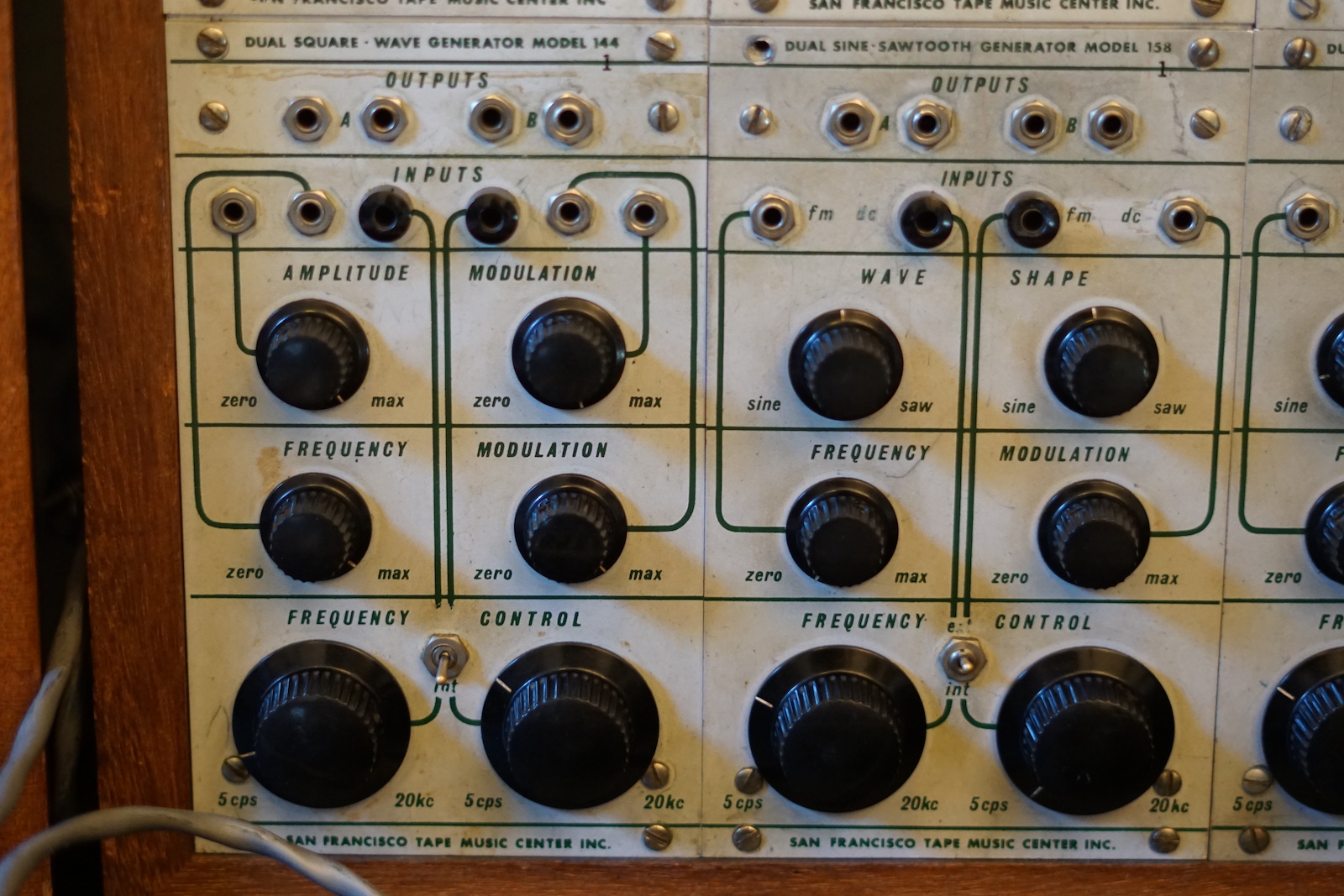
[Above: 158 and 144 dual oscillators in the prototype Buchla 100 system, housed at Mills College in Oakland, CA.]
This technique became fundamental in the creation of the "complex oscillator" concept, manifesting in such famous designs as the 208 Stored Program Sound Source and 259 Programmable Complex Waveform Generator. A so-called "complex oscillator" typically features two oscillators (generally acting as a carrier and a modulator), promoting modulation between the two—an effect that results in a wide range of complex timbres and tonal shifts.
In the years following Buchla's first engineering expeditions, many other synthesizer manufacturers also explored analog frequency modulation techniques. Examples include Moog's Minimoog, ARP's Odyssey and 2600, and oscillator modules in Serge modular systems such as NTO and PCO. It is also important to mention that this style of frequency modulation technique is not exactly exclusive to oscillators. It can be applied essentially to any function that includes a frequency or a rate parameter, including LFOs, looping envelopes, and of course, audio filters.
While the term "frequency modulation" was applied to these types of techniques in the 1960s and '70s, the general meaning of the term eventually changed/expanded. While it's still accurate to describe these techniques as a form of frequency modulation, the fully story of FM Synthesis (with a capital "S") is a bit more complex. And as with many such stories in the history of electronic musical instruments, these changes were directly related to advancements in technology.
The Origins Of Digital FM
Here is when things may get a little confusing. As you can see, frequency modulation as a method has been actively explored since the dawn of analog sound synthesis. However, what we today consider to be proper "FM Synthesis" isn't based on the timbre-altering effect discussed earlier—but instead, it is a comprehensive framework originally realized in the digital domain. And some of the core principles remain the same, FM Synthesis as a whole offers a much more nuanced set of ideas and techniques for realizing an immensely wide range of sounds that includes anything from harsh electronic noise to realistic emulations of acoustic instruments.
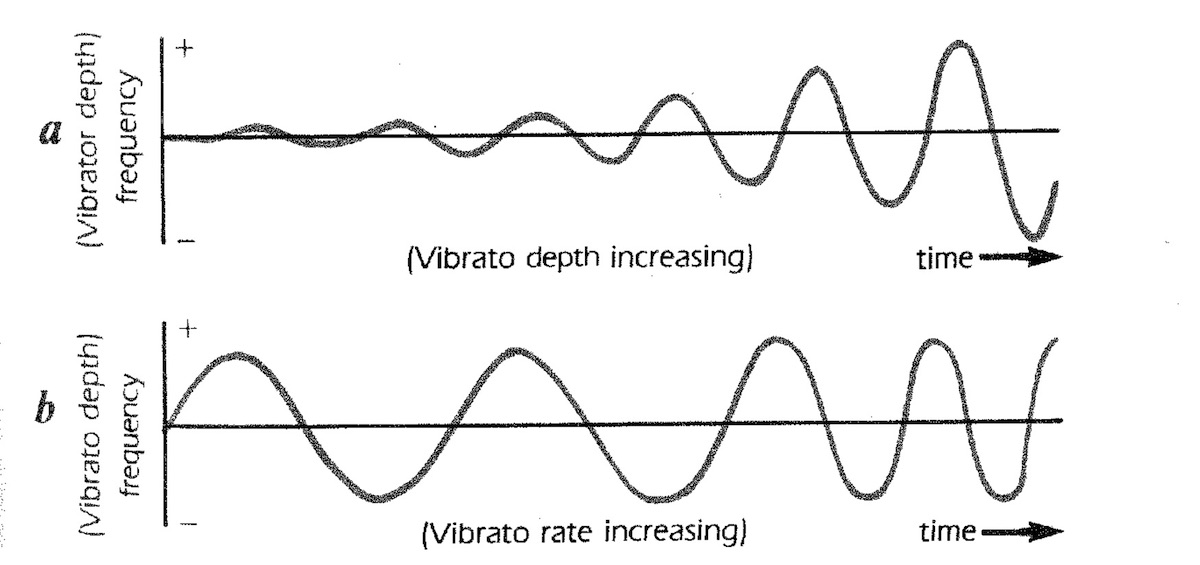
So-called FM Synthesis is rooted in the experimental research of the composer John Chowning conducted in the 1960s at Stanford University—basically in parallel with analog sound synthesis explorations mentioned earlier. When Chowning began his graduate studies at Stanford, the school was not among those few institutions that invested in building highly costly electronic sound studios. Inspired by the electro-acoustic music that was being made at the time—works by the composers like Karlheinz Stockhausen and Pierre Boulez—as well as his own musical experiments with electronic equipment during his earlier studies in Paris, Chowning, stripped of such opportunities at Stanford, began actively searching for an alternative to analog hardware.
Fortunately, he came across an article written by Max Mathews titled "The Digital Computer As An Electronic Musical Instrument". Thrilled by the possibilities, Chowning took a computer programming course at Stanford, and a year later he met with Max Mathews at Bell Labs, who then eagerly provided him with a set of punch cards for his groundbreaking Music IV program. Upon the composer's return to Stanford, AI pioneer John McCarthy granted Chowning weekend and evening access to the DEC and IBM mainframe computers at Stanford's Artificial Intelligence Lab. There, with the gained support from fellow researchers David W. Poole and James Anderson Moorer, Chowning began experimenting.
Chowning's work has always been driven more by his interest in musical composition than in electronics itself, and most of his earlier research in computer music was aimed toward sound spatialization. As such, the discovery of FM was driven not by rigorous calculations and engineering, but by the act of attentive listening—an "ear discovery," as the composer puts it.
One evening in the Fall of 1967, now an assistant professor of composition at Stanford, John Chowning was experimenting with extreme ranges of vibrato effects. He created two digital sine wave oscillators and used the output of one of them to alternate the frequency of the other. Increasing the rate and the depth of the modulation, Chowning suddenly realized that past a certain threshold, he no longer heard the vibrato effect, but instead, the sound gained a new timbral quality. The inquisitive composer then began to play around with the values corresponding to frequencies of both oscillators, as well as the modulation index...only to unfold a wide variety of complex, harmonically-rich tones. He then proceeded to add an envelope generator to shape the dynamic profile of the spectrum. In the next step, Chowning transposed the whole set maintaining the frequency ratios between the oscillators to confirm the reproducibility of the sonic effect in different ranges—and it stood the test.
Intrigued by the possibilities, the composer decided to attempt to recreate the sound of brass instruments electronically—something that was notoriously difficult to do with previously existing means of synthesizing sounds. He used a brass-like envelope applied to the modulation index, and with minor changes in different frequency ranges the composer managed to create believable brass tones. And contrary to the earlier research by Jean Claude Risset in using additive synthesis techniques to recreate acoustic sounds, Chowning's discovery did not require big stacks of oscillators—and extraordinary results could be achieved with minimal elements.
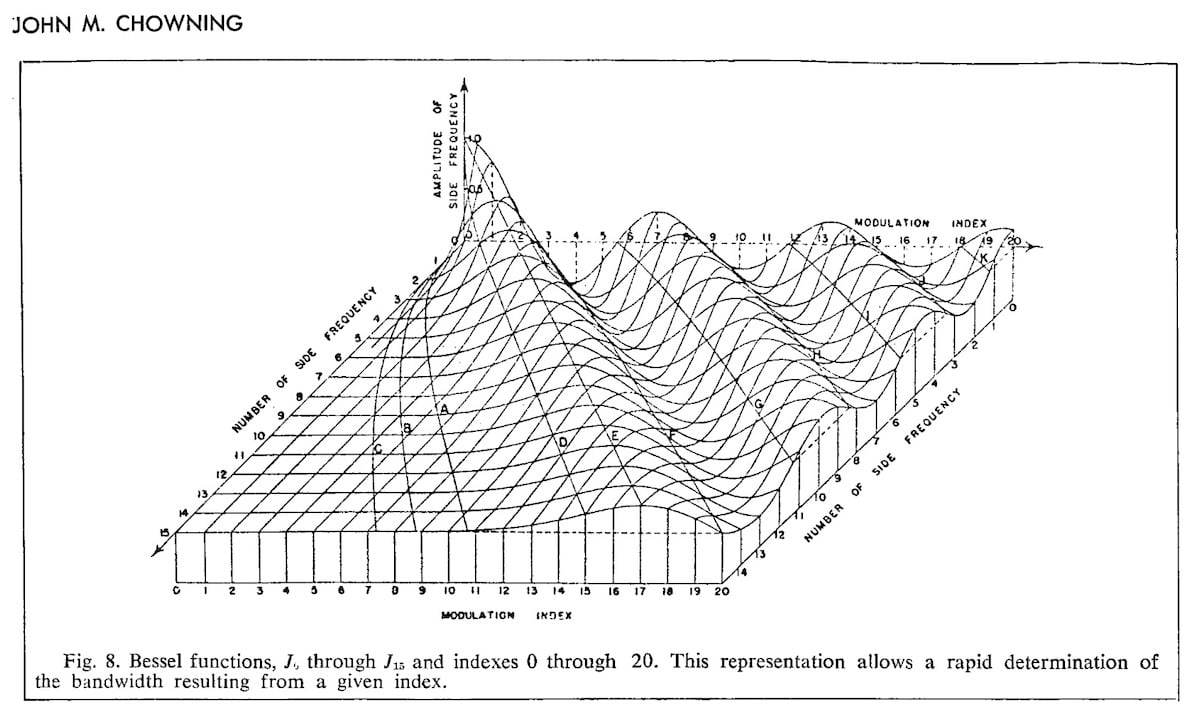
[A diagram detailing Bessel functions, from Dr. John Chowning's "The Synthesis of Complex Audio Spectra by Means of Frequency Modulation".]
Following his initial findings, the composer spent the next few years attempting to recreate many sounds of acoustic musical instruments using the FM method, and by the early 1970s, he championed a decent library of recipes. In 1973, Chowning published thoroughly outlined results of his research in the academic paper titled "The Synthesis of Complex Audio Spectra by Means of Frequency Modulation." The publication was also a part of Chowning's application to a tenured teaching position at Stanford, which unfortunately wasn't provided to him at the time. For a brief period, the composer relocated to France, following Boulez's timely invitation to play an advisory role in the creation of the state's national institution for experimental music research (what eventually will become IRCAM).
Chowning's position abroad, however was relatively short. Stanford attempted to lease the patent to many existing electric organ producers (including Hammond and Wurlitzer), yet the existing hardware technology wasn't capable at the time of taking advantage of Chowning's discovery. Fortunately, the potential of FM synthesis found significant interest at Yamaha, a Japanese musical instrument manufacturer who had already started researching digital technology for their keyboard instruments. Thus, in 1974 Yamaha purchased a license from Stanford, and for the next two decades, the company became the only (with a few exceptions) manufacturers of FM-focused synthesizers. Soon, Chowning returned to Stanford and founded the Center for Computer Research in Music and Acoustics (CCRMA), which is still active (and quite legendary) to this day.
FM Synthesis for the Masses
Once Yamaha licensed the patent to Chowning's discovery, the company spent the next several years in close communication with Stanford while they were developing their new digital FM instruments. The theoretical basis of the concept now required Yamaha to develop dedicated hardware, and the company was up to the task. And so, after several years of active development, in 1981 Yamaha introduced to the market their first commercial digital FM synthesizer—the quite piano-like GS-1 (pictured below).

The instrument featured a four-operator voice architecture, 16-note polyphony, and 2-part multitimbrality. While GS-1 was a significant breakthrough in digital synthesis technology, the instrument (and its successor, the GS-2) was prohibitively expensive, and only a handful of these instruments were actually produced. In the meantime, Yamaha also re-licensed the patent to other instrument manufacturers. Notably, New England Digital used it as the basis for the Synclavier.
The mass success of FM synthesis, however, arrived with the introduction of the DX series by Yamaha, and in particular the iconic DX7. Upon its release, DX7 was an instrument unlike anything else. Like its predecessor GS-1, it offered a generous 16-note polyphony, while the number of FM operators was increased to 6. Moreover, it offered an attractive minimalist interface, was light and portable, and importantly it was affordable. To this day, it remains at the very top of all-time bestselling synthesizers. The architecture and the hardware of the instrument endowed it with an uncommonly wide sonic variety, and a particularly recognizable tone quality—which, along with its vast assortment of ready-to-use presets, further contributed to its distinct position in the synthesizer hall of fame.
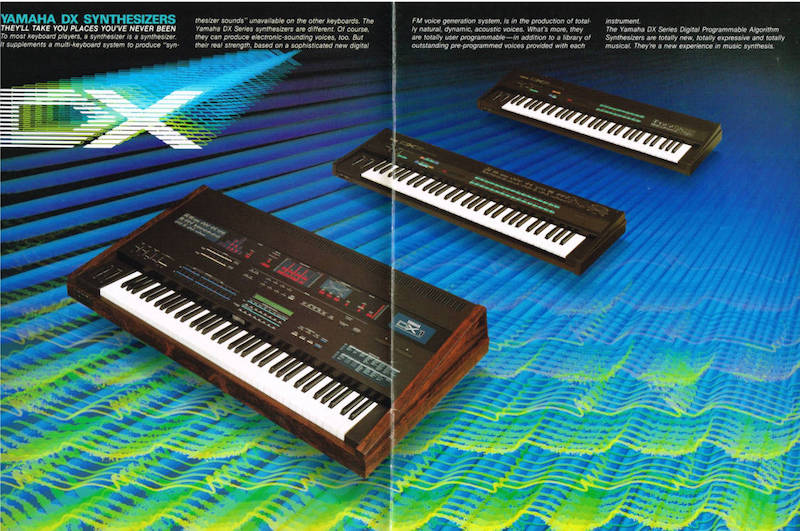
[Above: vintage advertisement for the Yamaha DX Series FM synthesizers]
The DX7, however, was notoriously difficult to program. Only a few brave souls were motivated enough to spend hours tediously creating new presets. This certainly played a role in the overall sound of '80s pop: the 32 default factory presets are all over countless radio hits from the era.
Yamaha undoubtedly played a defining role in realizing the potential of FM synthesis in hardware instruments. That said, even while the brand held an exclusive license to the technology, there were a few others who explored the possibilities of FM in some form or another, and in some cases pushed it much further. In the 1980s, Don Buchla was fully focusing on digital sound generation, and that decade in the inventor's career is highlighted by two mesmerizing, and now vanishingly rare instruments: the 400 and the 700.
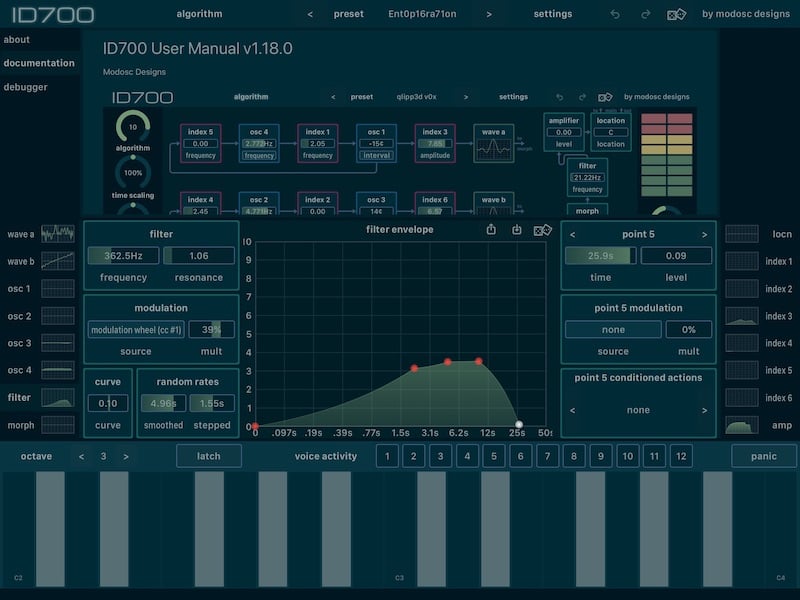 The modosc designs ID700 application, inspired by Buchla's 700
The modosc designs ID700 application, inspired by Buchla's 700
Both instruments took advantage the FM approach…but the 700 in particular was remarkably dense, offering 12-note polyphony with 4 oscillators per voice, intricate waveshaping options, a wide variety of FM algorithms, and 15 complex envelopes per voice (each envelope can have up to 96 breakpoints). As often was the case with Buchla's instruments, the 700 was remarkably advanced, and perhaps a bit ahead of their time. Only a small number of these instruments were sold—and you'd be hard pressed to find one today. (Fortunately, you can have a taste of the 700 via the software emulation iD700 by Jon Schatz/modosc designs.)
Whether Buchla's design featured a computationally novel approach to FM, or simply flew under the radar during the era of Yamaha's FM monopoly isn't entirely clear. At the same time, larger companies like Casio were inspired to develop their own technology which was not based on frequency modulation per se, but provided similar timbral effects. They called it Phase Distortion Synthesis (PD), and it became the core technology in the affordable CZ-series synthesizers.
In 1995, Yamaha's patent expired, and FM synthesis now is openly used in a wide range of software, and hardware synthesizers including NI FM8, Ableton Operator, Elektron Digitone and Model:Cycles, Korg Volca FM, Kodamo Essence FM, and Yamaha Reface DX. There are also a few Eurorack modules that allow you to explicitly explore digital FM synthesis in the context of a modular synthesizer. These include the ALM Akemie's Castle and Akemie's Taiko, Industrial Music Electronics Hertz Donut MKIII, RYK Modular Vector Wave, and plenty of others.
FM Terminology Demystified
As you may have noticed, we have already introduced a few terms, words like operators and algorithms, that are specifically related to FM Synthesis. This is an element that accompanies many new inventions, and so along with FM Synthesis arrived a new sonic vocabulary. In this section, we will identify all of the key terms associated with FM Synthesis, but before we go there we should more directly acknowledge a detail that we've conveniently avoided up until this point: Chowning's FM and analog FM are just not the same thing.
Conventional analog FM, as we said before, is truly about using one oscillator to control another oscillator's frequency. Typical analog FM is exponentially-scaled. Analog oscillators commonly adhere to the 1V/oct standard, which means that it always takes 1 volt to go from one octave to another. However, since the relationship between pitch and frequency is exponential, the distance to the upper octave is always twice longer as to the lower octave. If the center is 200Hz, the upper octave is 400Hz, while the lower is 100Hz. Thus, the center frequency drifts when we plug in a modulating wave that evenly oscillates up and down. Exponential FM is great for percussive sounds, as well as gnarly and unpredictable inflections. But it doesn't remain terribly stable at high indices—the oscillator pitch drifts upward and can be difficult to control.

The method implemented by Chowning employed a linear frequency mapping system. This is the result of a particular quirk about his approach: it's not actually about modulating an oscillator's frequency, but instead, its phase...which, with an appropriate combination of modulation frequency and index can have an obvious audible effect on the frequency of the produced sound. So, in effect, it's not wrong to call this method frequency modulation, since it's still based on a method that modulates the apparent frequency of the sound—but on a technical level, the core oscillator frequency never actually changes, only its phase. Today, it's relatively common to refer to Chowning's approach to digital FM as Phase Modulation Synthesis.
Perceptually, the effect of linear FM on the timbre of a sound is quite similar to the traditional exponential approach. However, it is characterized by advantageous pitch stability that is essential for gaining precise harmonic ratios.
Over the years, instrument manufacturers managed to incorporate linear frequency modulation in analog oscillators too. These days, it is not uncommon to see exponential and linear FM inputs side by side on analog sound generators. You will also encounter occasionally something called thru-zero FM—a special kind of linear frequency modulation directly related to Chowning's phase modulation approach. TZFM allows a modulated oscillator to automatically reverse its phase upon reaching 0Hz (typically, an oscillator would stop at that point). The practical effect of this is superior pitch stability, and increased capacity for wild modulation without necessarily disturbing the sound's pitch stability.
Now that we've covered all of the different types of frequency modulation, let's demystify the remaining terms. So what is an FM operator? An operator is a set of rudimentary tools comprising an oscillator (traditionally a sine wave generator), VCA (for controlling loudness or modulation depth), and at least one envelope generator (most commonly used for altering the FM Index). Basic FM synthesis patches can be accomplished with a mere two operators, but dedicated FM synths often feature 4-, 6-, and even 8-operator voice architecture. An operator can serve as a carrier, a modulator, or both. The FM algorithm determines the function of a particular operator—essentially, a structure that defines how multiple operators are routed.
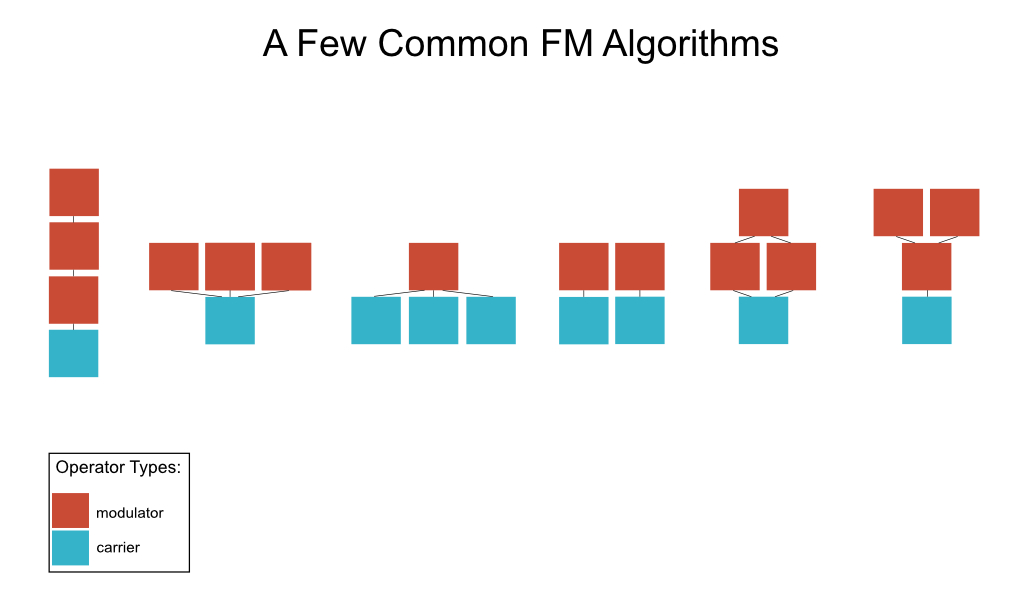
Different FM synthesizers offer a varied number of available algorithms, many of which are variations on common shapes like cascade (operators modulating each other in series), branch (multiple modulators to a single carrier), and root (single modulator to multiple carriers). While the number of operators involved in an algorithm proportionally relates to the complexity of the tone, even more harmonically rich effects can be achieved through the FM feedback technique, where an operator is set to modulate its own frequency At extreme mod index settings, the result of this sort of feedback is a sort of a pitched noise. However, using feedback sparsely can be very effective for brightening up a sound.
All in all, in order to feel at home with FM Synthesis, it is necessary to pay careful attention to what effects frequency ratios, envelope shapes, and level differences between operators have on each other. Taking control of these parameters will grant you a key to an inexhaustible realm of sonic flavors.
FM Synthesis: Pros and Cons
Frequency modulation synthesis is incredibly robust, as it allows you to create a wide variety of rich sounds with only a handful of elements—a lot can be done with a couple of oscillators, envelopes, and VCAs. Moreover, the inventors of current-day FM-based instruments learned how to design interfaces and workflows which are much more welcoming and creatively inspiring than what was offered by the classic FM synths. Devices such as the Elektron Digitone, for instance, make the process of sound design nearly as instantaneous and rewarding as the process of music-making itself.
So what is a possible downside of FM-synthesis then? Reportedly some consider sounds created via digital FM method to have a certain "cold" quality (of course, in comparison to the "warm" tone of analog synthesizers). While this definition is arguable, digital FM without a doubt has a unique character, which may be enjoyed by some, and not as much by others. Furthermore, at high-frequency settings of the modulator and carrier operators, sideband harmonics can escape the limits set by the sampling frequency of the system, causing aliasing effects. That said, it is possible to treat these sonic effects as something that adds charm to the sounds, and if you want to make FM sounds a bit "warmer", you can always process them through analog enhancers such as filters, compressors, and saturators.
But overall? We appreciate FM Synthesis for what it is: yet another distinct tool for creating and shaping sounds that would be impossible with other approaches.

